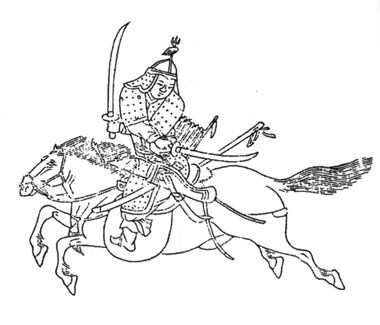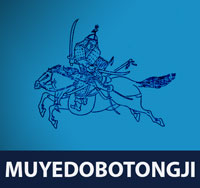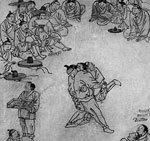Taekwondo 태권도Taekwondo Preschool
Korean martial arts are military practices and methods which have their place in the history of Korea but have been adapted for use by both military and non-military personnel as a method of personal growth or recreation.
About Muyedobotongji 무예도보통지
The Muyedobotongji is widely regarded as a resource for understanding the nature of Korean military science in the 18th century.
Commissioned by King Jeongjo (r. 1740–1810) in 1790, the Muyedobotongji (or Muye Tobo Tong Ji, translating to "Comprehensive Illustrated Manual of Martial Arts") expanded on the eighteen weapons systems identified in the Muyeshinbo of 1758. Written by Yi Deokmu (이덕무, 1741–1793), Pak Je-ga (박제가, 1750–1805) and Baek Dong-soo (백동수, 1743–1816), and published in four volumes in 1795, it preserved the methods and practices of the earlier work while adding equestrian training by executing six of the earlier weapons on horseback (마상육기 馬上六技 or 마상6기), extending the system to "twenty-four [martial arts] methods" ([무예]이십사 / [武藝]二十四技). While little more than a field manual for cataloguing required skills, the Muyedobotongji is widely regarded as a resource for understanding the nature of Korean military science in the 18th century.
Background
Destruction of the Korean palace and its libraries in 1126 as well as the Mongol invasion in 1231 and subsequent Mongol domination of Korea (Yuan Dynasty 1231-1356) has eliminated any literary history of Korea prior to that time. As a result an appreciation of Korean Military Science prior to the 13th Century is very much a matter of scholarship in studying the writings and practices of Koreas neighbors. However, in 1145, King Injong (r. 1112-1146) ordered a Confucian Scholar, KIM Bu-sik, to compile SAMKUK SAGI (lit. "History of the Three Kingdoms"). Some 100 years later a Buddhist monk, Iryeon, compiled the SAMKUK YUSA (lit.: "Memorabilia of the Three Kingdoms"). Both works indicate that militant attitudes between and among the three major States of the Three Kingdoms Period (37 BCE - 660 AD) resulted in each nation developing an institution for training its warriors in Military Science. Military Science continued to develop to very high levels up to and through the 12th Century but was ultimately destroyed by the Mongol onslaught.

With the end of Mongol dominance, predations and incursions by coastal raiding forces of mixed nationalities ("Wa-Ko")provided the Korean administration with some rationale for rebuilding Korean Military installations and units. However, such efforts were undercut by Neo-Confucian thought that disparaged Military practices in favor of leadership by scholars and bureaucrats. As a result, Korea was unprepared for the invasion by Japanese armies in 1591 intent on using Korea as an approach for conquering China. Known as the "Imjin Waerum", the Japanese advance easily over-ran the Korean army and was stopped only by the Ming Army and the patriotic efforts of Korean nationals formed into "righteous armies" (K. "UBIYONG"). In September, 1593, King Sunjo (1567-1608) established the HUNLYUN DOKAM ( Royal Military Training Agency). At the encouragement of the Ming General Liu, T’ing, the Korean Prime Minister, Yu Song-Nyong, sought to reorganize the Korean army into a highly structured and versatile organization. His guide for this effort was the 'JIN XIAO SHIN SHU' or “Manual of New Military Tactics” written by General Qi, Ji-Huang (1528-1588) and published in 1567. Having found the Ming Army in similar dis-array against pirates in Southern China, General Qi's manual had proven successful in producing a hard-fighting and victorious army.
Following the end of hostilities in 1598, the Korean government sought to record all material that they had found useful, rather than adopt the manual of General Qi in its entirety. As a result the MU YE JEBO (“Martial Arts Illustrations”) was published in 1610. Ordered by King Sunjo (1567-1608), the work was compiled by one of the king’s military officers, HAN Kyo, and consisted of 6 fighting systems. These included the KON BANG (long stick), DUNG PAE (shield), NANG SUN (multi-tipped spear), JANG CHANG (long spear), DANG PA (triple-tip spear) and the SSANG SOO DO (two-handed saber). Conspicuous in its absence was the KWON BEOP material for unarmed fighting,
During the reign of King Youngjo (1724-1776) the MU YE JEBO was revised and supplemented with 12 additional fighting methods by Prince Sado who originated the term SIP PAL KI (“Eighteen Fighting Methods”). Though often confused with Chinese practices of the same name and later 20th Century practices, the term coined by Prince Sado, a shortened form of BONJO MUYE SIP PAL BAN ("18 Martial Arts Classes of the Yi Dynasty"), identified this collection of 18 fighting systems. In addition to the original 6 systems of the MUYE JEBO were added JUK CHANG (Long Bamboo Spear), KEE CHANG (Flag Spear), YEDO (Short Sword), WAE GEUM (Japanese Sword), KYO JUN BO (Illustrations of Combat), JEDOK GEUM (Admirals Sword), BON KUK GEUM BEOP (Native Sword Methods), SSANG GEUM (Short Swords), WOL DO (Crescent Sword), HYUP DO (Spear Sword),PYON KON (Korean Flail) and KWON BEOP (Fist Methods).
It was the MU YE SHINBO that was ordered revised by King Cheongjo (R.1776-1800). Supplemented with 6 additional fighting skills, these "new" methods were little more than dismounted methods such as spear, sword and flail which had been modified for execution from horseback. KWON BEOP material was also further modified with the addition of material performed between partners. The material was intended to reflect a combat format in deference to Neo-Confucian thought, by having partners use matched methods which would only produce a "stalemate" rather than a victory of one partner over another. Though ideologically satisfactory, the practice rapidly fell into disuse for its lack of practical combat effectiveness. This revised publication is titled the MU YE TOBO TONG Ji (“Comprehensive Illustrated Manual of Martial Arts”) and was published in 1795. Also added KWAN BOK DOSUL (Illustrations of Uniforms) as well as a last chapter that qualified material as to its execution by a particular service.
Though adequate for the nature of warfare prior to the introduction of firearms, the use of these practices fell prey to advances in technology as well as the Confucian ideologies of the Korean court which disparaged Military Science as well as technology. In 1907 Korea's neighbor, Japan imposed its administration on Korea and dissolved the Korean Army. During the Japanese Occupation, an orchestrated effort to substitute Japanese culture for that of Korea was conducted including the imposition of Japanese Language, Japanese practices and even Japanese surnames. The methods and practices of the MUYE TOBO TONG JI were conserved only a very limited fashion.
Today traditional Military Science identified in the MUYE TOBO TONG JI has become the focus of dilligent research and ardent national pride. Re-enactment groups, both civilian and military seek to preserve the practices which are a direct reflection of Korea's history.
Contents
Volumes 1 to 4 focus on polearms and swordsmanship. The fourth volume treats unarmed combat (gwonbeop "boxing"), blunt weapons (staff and flail) and equestrian skills.
Original to the 1795 Muyedobotongji are six methods of mounted combat: Gichang (spear fighting on horseback), Masang Ssanggeom (twin swords on horseback), Masang Woldo (crescent sword on horseback), Masang Pyeongon (flail method on horseback), Gyeokgu (ball game on horseback), Masang Jae (horsemanship).
Volume 1
- Long spear or lance - Jang chang (Hangul: 장창, Hanja: 長槍) a 5-foot-long (1.5 m) spear made from the wood of the yew tree. It can also be made from a similarly soft wood, including bamboo in the right climate. It was considered the most effective conventional weapon on the battlefield due to its flexibility and length. The jang chang was widely used in the battle to retake Pyong-yang Fortress during the 1592 war between Chosun (Korea) and Japan.
- Long bamboo spear - Juk jang chang (Hangul: 죽장창, Hanja: 竹長槍) 20-foot-long (6.1 m) spear tipped with a 4 inch blade where the shaft was made of bamboo which gave more flexibility.
- Flag spear - Gi chang (Hangul: 기창, Hanja: 期槍) A 9-foot-long (2.7 m) staff with a 9-inch-long (230 mm) blade at the end.
- Trident - Dang pa (Hangul: 당파, Hanja: 鐺鈀) Trident. The middle spear was longer for deeper penetration. It is between seven feet, six inches and eighteen feet long and has either an iron or wooden tip.
- Spear on horseback - Gi chang (Hangul: 기창, Hanja: 騎槍) Use of the Ki chang on horseback.
- Thorny spear - Nang seon (Hangul: 낭선, Hanja: 狼先) Spear with nine to eleven branches or thorns extending out from the main shaft, each studded with small metal hooks. These thorns could be dipped in poison.
Volume 2
- Long sword - Ssang su do (Hangul: 쌍수도, Hanja: 雙手刀) Sword that had to be handled with both hands. The long sword is handled with both hands. These frighteningly big, heavy swords were originally called "long swords" (jangdo), or sometimes "applying sword" (yonggum) or "plain sword" (pyunggum). Swords of this type came to be known during invasions of China since they were used by Japanese pirates invading China's coastal areas. Wielding these swords, the Japanese pirates cut long spears, or even enemy soldiers, into half in a single strike. The long sword skills were therefore introduced in Korea to prepare its troops for combat against Japanese pirates.
- Sharp sword - Ye do (Hangul: 예도, Hanja: 銳刀) Also known as dando or hwando. A double-edge sword was called a geom while a single-edged sword was called a do.
- Japanese sword - Wae geom (Hangul: 왜검, Hanja: 倭劍) This chapter describes the use of Japanese swords. Their use was studied during the Imjin Waeran.
Volume 3
- Commander sword - Jedok geom (Hangul: 제독검, Hanja: 提督劍) Was, just like the Yedo, carried around the waist. This sword can thank its name to commander Li Rusong.
- Korean sword - Bonguk geom (Hangul: 본국검, Hanja: 本國劍) Also known as sin geom (신검). Represented the swords use by the hwarang from the Silla dynasty. It bore close resemblance to the double edged sword of the Eastern Han.
- Double sword - Ssang geom (Hangul: 쌍검, Hanja: 雙劍) A set of equally sized swords.
A fighting skill using two swords with both hands, this was one of the most difficult skills to master. Double swords on horseback required even greater prowess. The fighter could attack and defend at the same time using two swords. The smaller, saber‐size swords with round hand guards (hwando) were generally used for this technique. The swordsman kept a pair of swords, one referred to as male and the other one as female, in a single scabbard to draw them quickly. The well-known double swords folk dance (Ssanggeommu) was derived from this skill.
- Double sword on horseback - Masang ssang geom (Hangul: 마상쌍검, Hanja: 馬上雙劍) This chapter describes the use of ssang geom on horseback.
- Halberd - Woldo (Hangul: 월도, Hanja: 月刀) A weapon, literally "moon knife", which is often compared to a European halberd although it more closely resembles a glaive with a large head.
- Helberd on horseback - Masang woldo (Hangul: 마상월도, Hanja: 馬上月刀) This chapter desbribes how to use the wol do on horseback.
- Short halberd - Hyeopdo (Hangul: 협도, Hanja: 挾刀) Shorter version of the wol do.
- Shield - Deungpae (Hangul: 등패, Hanja: 藤牌) The use of a shield with a throw sword or throwspear. This chapter counts for two separate methods.
Volume 4
- Unarmed fighting - Gwonbeop (Hangul: 권법, Hanja: 拳法) This chapter contains eighteen forms for unarmed fighting.
- Stick - Gon bong (Hangul: 곤봉, Hanja: 棍棒) This chapter describes how to use the long stick in battle. Staff techniques entail strike, stab, block, parry etc. These techniques are fundamentals of all weapon techniques. After mastering staff skills, the study of other pole arms such as spear, sword, trident, moon sword etc. is accessible.
- Flail - Pyeongon (Hangul: 편곤, Hanja: 鞭棍) This weapon is made out of a long and short stick connected with a piece of rope or chain. Instead of a steel ball of spikes, the short stick acted as a flail, overfitted with a steel skin that had many painful protrusions.
- Flail on horseback - Masang pyeon gon (Hangul: 마상편곤, Hanja: 馬上鞭棍) This chapter described how to use the flail while riding a horse.
- Korean polo - Gyeok gu (Hangul: 격구, Hanja: 擊毬) A game that resembles polo. Used to upgrade the riding skills of the cavalry, this sport was uniquely played by the Goguryeo cavalry as early as 400AD. The ball must be scored in a goal, but players must ride, hang or be in whatever position on a horse without touching the ground. Players may only touch the ball with a stick with a tightly bent loop on one end. They can balance the ball on the loop while riding, or throw it.
- Equestarian skills - Masang jae (Hangul: 마상재, Hanja: 馬上才) Six equestarian skills that the cavalry should master. This includes standing upside down on the horse, repetitively jumping from one side of the horse to the other, riding under the horse, riding two horses simultaneously, etc.
Sources
Earlier sources can be traced to Chinese General Qi Jiguang's treatise on troops training, the Ji Xiao Xin Shu (Hangul: 기효신서, Hanja: 紀效新書, "New Books of Effective Methods"). Ji Xiao Xin Shu was written in 1561. The authors considered that although this type of training had little value for large-scale battle, it was nevertheless useful to train bodily flexibility, reflexes, hands speed, quick yet solid footwork and jumping capacity, all of which were very valuable for a warrior.
Improvements
As a manual, the Muyedobotongji made several improvements over its Chinese sources since many practical comments on training and the value of the described techniques were added, and shows the influence of the neighboring Chinese martial traditions on the Korean peninsula.
The book divides the techniques into stabbing, cutting and striking techniques, while earlier books divided them into long and short weapon skills. The old classification method had to be abandoned with the development of firearms. The long spear had lost its function as a long-range weapon by the time the book was written. Quite clearly, first bow and arrow, and later the advent of firearms, rendered the long spear obsolete in this role.
RESOURCES
This article uses material from the Wikipedia article "Muyedobotongji", which is released under the Creative Commons Attribution-Share-Alike License 3.0.














